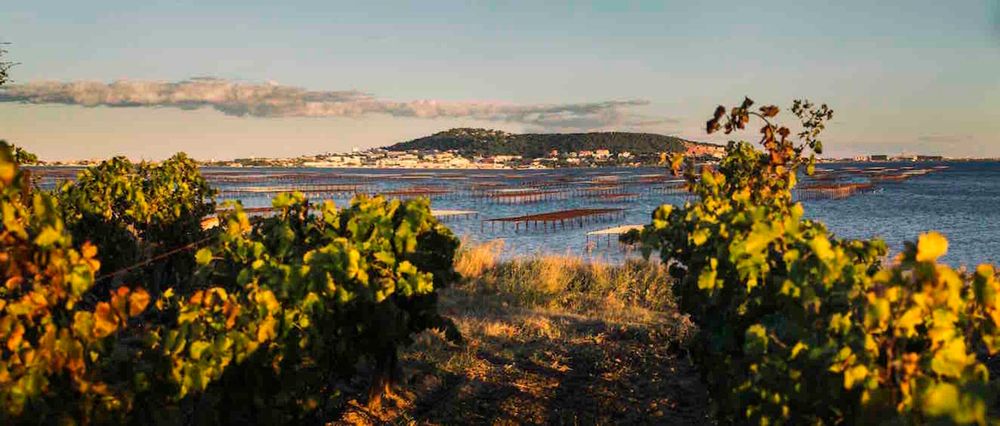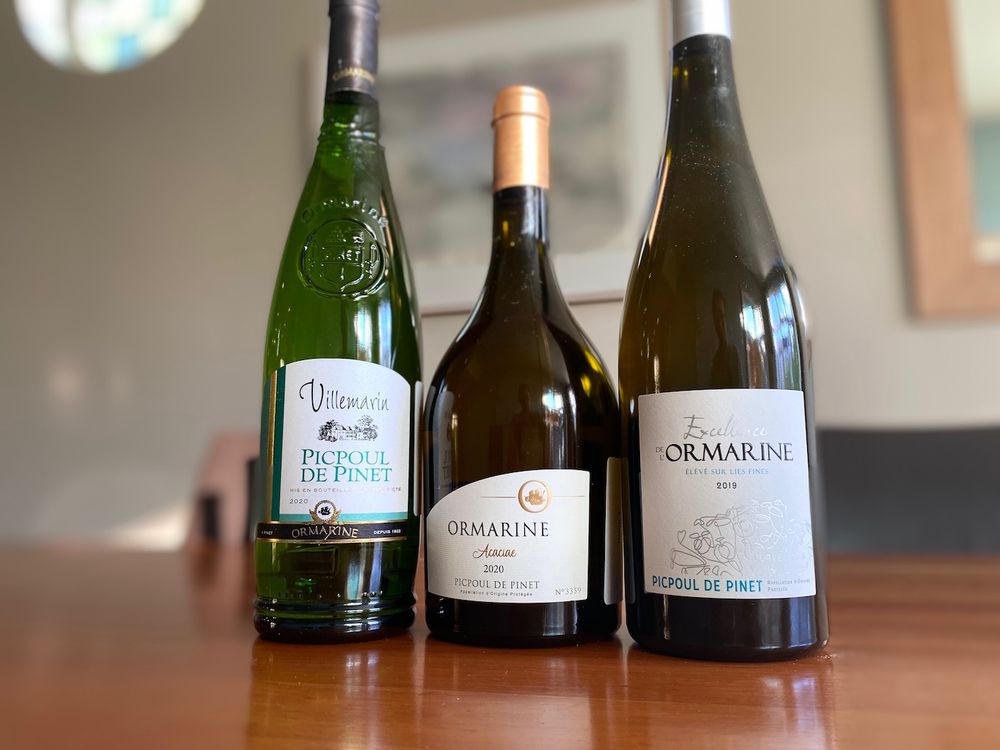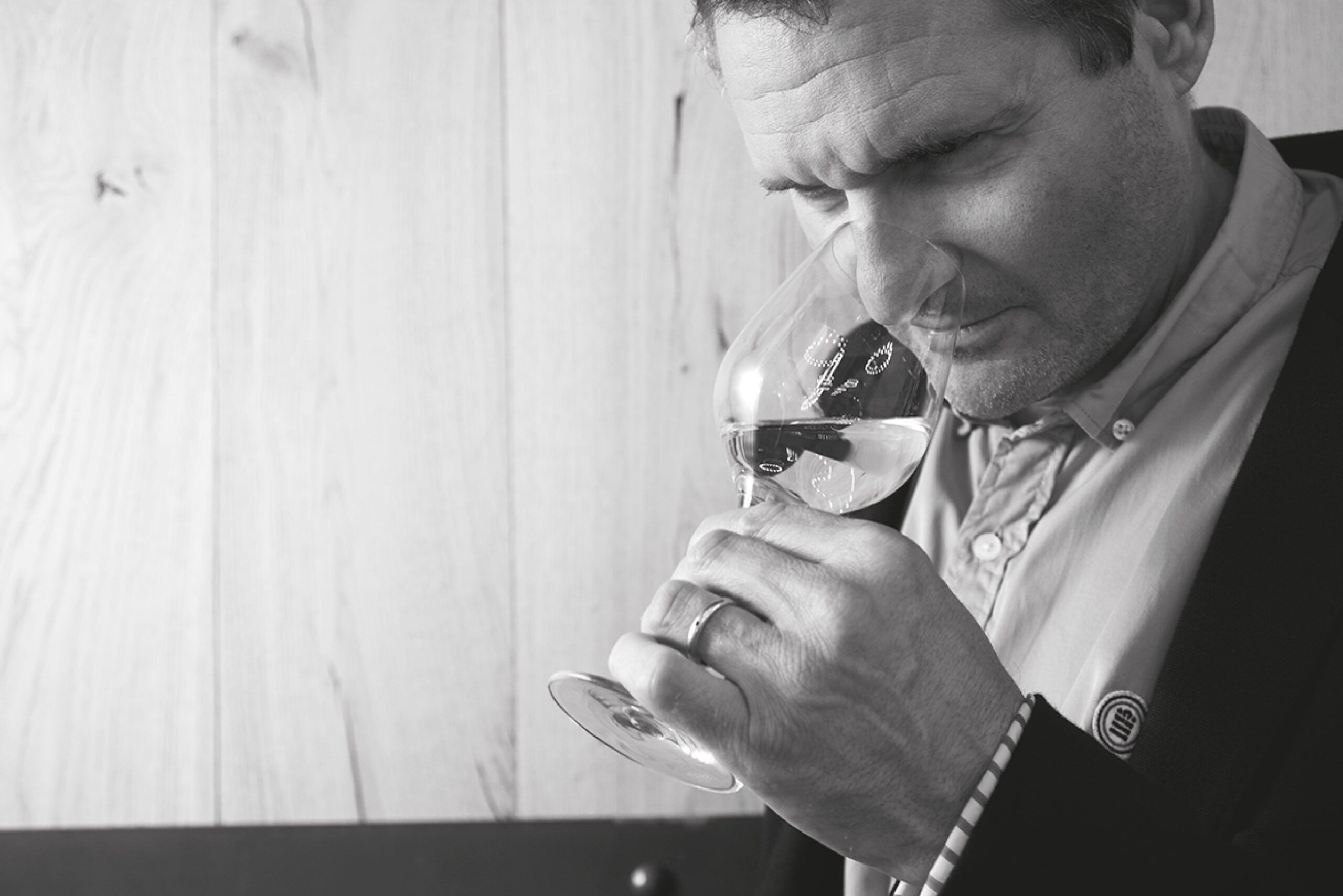“I think we need more stand out Picpoul de Pinets to break a few glass ceilings in terms of price and recognition,” says Munson.
The meteoric rise of Picpoul de Pinet over the past 20 years has been nothing short of extraordinary. Grown in a small 1400 hectare Languedoc AOP around the Thau lagoon to the west of the Mediterranean Golfe de Lyon, it has gone from being the relatively obscure base wine for the region’s depleted vermouth production to becoming the go-to table white of many a UK home.

Proximity of the vines to the sea and lagoon brings salinity to the wine
Us Brits import more Picpoul than any other country, with over 1.5 million bottles sold and no sign that its recent popularity is waning. In 2020 Picpoul sales in the UK soared by 60%. Picpoul de Pinet now accounts for 80% of all white wine exports from the Languedoc and it makes up 57% of all the Languedoc’s still white wine production.
The main reason is that the wine delivers – it is fresh, lively, vivacious, textural and (whether real or imagined) has a salinity that comes from its proximity to the Mediterranean oyster beds of the region. But there are a score of other reasons: It pairs well with shellfish, or drunk on its own; A lack of vintage variation gives a consumer-friendly consistency to the wine; Picpoul and Pinet are both easy to pronounce for an English-speaking customer base; the bottle is easily identifiable in a way Muscadet used to be, before fashion dictated otherwise; and almost every bottle gives you a handful of change from a tenner.
Iain Munson MW, head of winemaking at Maison Jeanjean, believes Picpoul has become a regional brand much like Chablis or Rioja. Having been making Picpoul for the past 15 years and basing his masters of wine thesis on it, this East Londoner has become something of an expert on the subject.
“Most Picpoul is the same style, has a similar price point and is in the same bottle which led it to becoming a brand that consumers had confidence in. You know what you are getting when you ask for a Picpoul. These days people ask for a Picpoul in the same way they would ask for a Chablis or a Rioja – it has become a regional brand. Something that other appellations should note of!”
Credit must also be given to the smart, clear control exercised by the appellation’s powers-that-be; they successfully fought for Picpoul to be excluded from other regions as an allowed grape variety, and have also launched a quality benchmark for the region’s manly-local growers, to up the quality of the wine and get it onto restaurant tables.

The new wine Acacaie, matched with lobster and garlic butter
Ageing Picpoul de Pinet in acacia wood
Part of this trend has seen Cave de L’Ormarine launch a new wine, Acaciae, this month, a vin de garde Picpoul de Pinet that has 75% of the cuvée aged for four months on its lees in acacia barrel.
“Or Picpoul with a bit of Oomph! – to give it its technical term,” laughs Iain Munson MW.
Ormarine is the clear market leader in AOC Languedoc Picpoul de Pinet with 580 hectares of vine (or 42% of the total area under vine in the appellation); in 2019 Ormarine sold an eye-watering 3.2 million bottles of Picpoul de Pinet. The company has had a distribution agreement in place with Maiaon Jeanjean since 1985, the company that Munson has been head of winemaking at for the past 15 years.
“We wanted to see how much you can do with a white wine… without going completely out of the box,” he says.
The first example of making their Picpoul more complex is a wine called Excellence de L’Ormarine, which has been aged on its lees in steel tank. The next step was to experiment with wood, of which there have been only a few examples in the region.
Munson explains that Ormarine started experimenting ageing Picpoul in French and American oak in 2019, “but I am not a fan as the oak overpowers the Picpoul.”
He settled, however, on four months ageing in large format acacia barrels, on the strength of its track record with ageing Sauvignon Blanc.
“Acacia wood accentuates all the aromatic qualities of Picpoul and does not dominate the natural expression of the grape and its special terroir,” he says.
In order to get the equilibrium right between giving structure to the wine, and preserving the wine’s aromatics and freshness they settled on four months ageing – any more and the wood dominated too much.

Iain Munson MW, May 2021
Munson explains that projects like his lees-aged Picpoul Excellence de L’Ormarine and the barrel-aged Acacaie are a direct result of working in a monocepage – as a winemaker it encourages you to push the envelope. But does he think that customers share this appetite for a more complex, more expensive Picpoul cuvée such as Acacaie?
“For a small number of consumers yes. People are familiar with Picpoul now and I think they might be curious to see what you can achieve with this grape.”
And are they the same people who might buy Picpoul from a supermarket?
“No, I think Acaciae is for on-trade and independent wine merchants,” says Munson, “It will require hand selling. So for example if a customer was ordering a fish or seafood dish that was fairly rich like lobster in a buttery sauce, I would recommend Acaciae as it has more structure and body to balance these dishes. If they were eating plain oysters, I would stick to classic Picpoul.”
The Languedoc has seen a number of new ‘icon’ wines coming out of the region in recent years, so does he think they have got the timing right?
“If the wine is good enough why not. I see many superb wines from the Languedoc that do not get the same recognition because they are not from the Rhône or Bordeaux. I think we need a few more stand out Picpoul de Pinets to break a few glass ceilings in terms of price and recognition.”
So how were the wines tasting?

Villemarin Picpoul de Pinet, 2020, Cave de L’Ormarine
This is the classic £10 Picoul from Majestic. Medium straw coloured; attractively floral and fruity nose – honeysuckle, citrus fresh sunny herbs, sea air; the palate is refreshingly crisp and zesty, Munson described it as “Apple tart made with Granny Smith” which is spot-on as it has that green apple flavour but with tropical notes and other tastes coming in, and also a sturdy backbone of acidity. The wine has a nice salinity to it, and a citrus skin texture on the finish which makes you want to reach for another glass. Surprisingly complex given the price point. Classic Picpoul de Pinet which pairs well with oysters, shellfish and rich cheese.
Excellence de L’Ormarine, Picpoul de Pinet, 2020, Cave de l’Ormarine
This is not yet available in the UK which is a shame as it’s a nice shift from straightforward Picpoul de Pinet – having been left on fine lees after an initial racking, so that once fermentation has finished there is no more racking required and everything goes in the bottle, clean as a whistle. The result is a Picpoul with more roundness, depth, weight on the palate and richer aromatics. You find honeysuckle and a dusting of white pepper on nose; the palate is faintly luxurious, sweet lemon, a hint of yellow stone fruit, saline and a nice grapefruit-pith bitterness to the finish.
Acaciae, Picpoul de Pinet, 2020 Cave de L’Ormarine
This is the new project from Cave de L’Ormarine, a Picpoul de Pinet with 75% of the cuvée aged for four months in acacia wood, the rest on fine lees. The aim is to make an ‘icon’ Picpoul de Pinet that appeals to lovers of fine white wine and not just Picpoul.
I think Munson and co. have certainly achieved this – the wine is delicious and sits comfortably in the £20 retail price point – although it might take a master of wine to connect the aromatics and flavour profile with Picpoul (those devising future blind tasting exams take note!) Having said that the wine still has a sturdy structure, high acidity and salinity, but rather than fresh, zingy citrus this wine is more about complexity and evolved fruit – tarte aux pommes, ‘orange and lemon slices’, honeyed toast, and a herbal note – I was getting wild fennel crossed with young spruce needles; the palate is fresh, rounded, with a good degree of concentration.
We tasted this solus and with oysters and griller lobster and garlic butter from London’s famed seafood restaurant Bentley’s Oyster Bar & Grill. The wine absolutely delivers quality and value for money – in a gastronomic context, the wine is a very good match with lobster, the more buttery and robust the sauce the better I feel. The wine has enough structure and flavour to age for another 3-5 years, although it is drinking well now and doesn’t necessarily need to age further.
Villemarin Picpoul de Pinet, 2020 is available from Majestic for a retail price of £9.99, Excellence de L’Ormarine and Acaciae are not yet available in the UK.










































